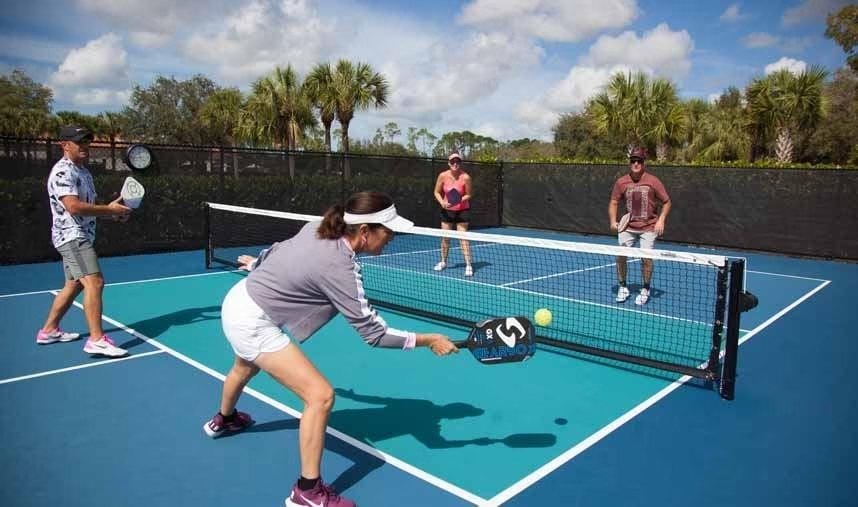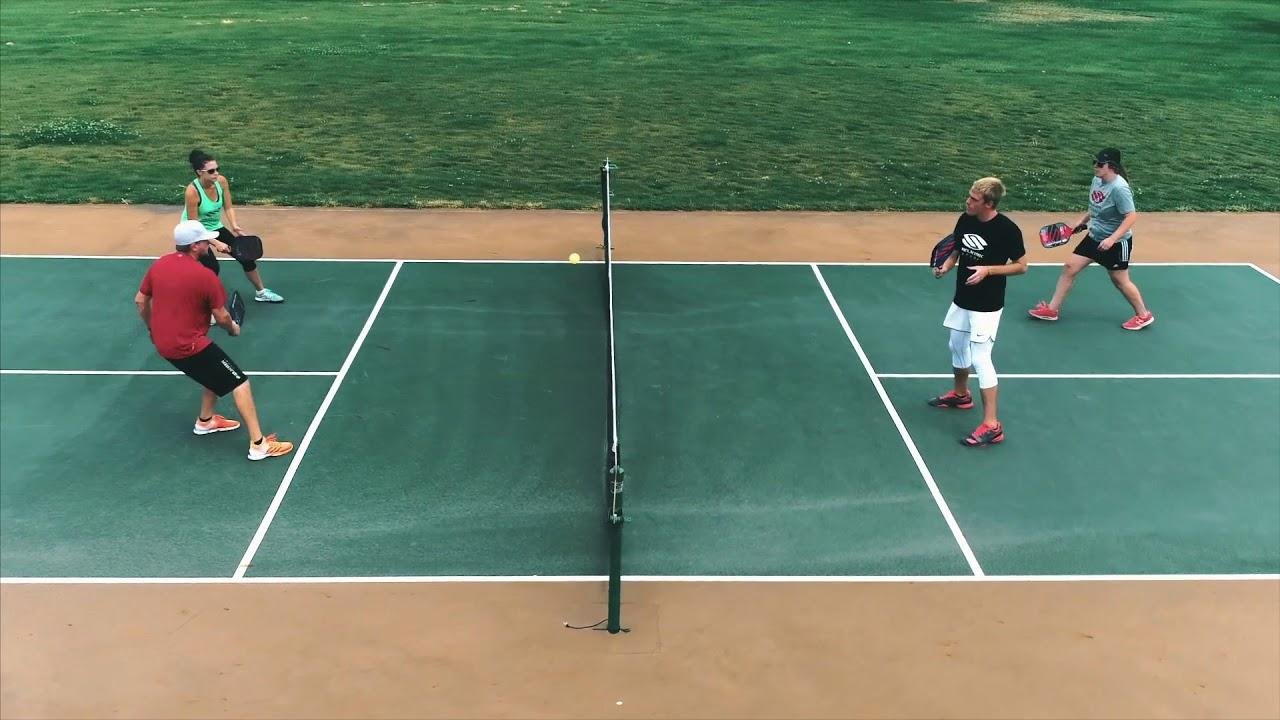Blog
is pickleball like tennis

In a world where sports continually evolve and new games emerge, the rapid rise of pickleball has sparked curiosity and debate among athletic enthusiasts and casual players alike. With its vibrant courts and friendly atmosphere, pickleball is often likened to tennis, yet it stands on its own with unique characteristics and distinct gameplay. But just how similar are these two net games? In this exploration, we will delve into the origins, rules, and playing styles of both sports, inviting you to discover whether pickleball is merely a playful cousin of tennis or a distinct entity carving out its own identity in the realm of recreational fun. Join us as we unravel the nuances that separate and connect these two beloved games, revealing the fascinating interplay of tradition and innovation that defines modern racquet sports.
Exploring the Fundamental Differences in Gameplay Dynamics
When comparing pickleball and tennis, one must delve into the distinct gameplay dynamics that set these two racket sports apart. Court dimensions vary significantly: pickleball courts are smaller, measuring 20 feet wide and 44 feet long for doubles matches, while a standard tennis court stretches to 36 feet wide and 78 feet long. This size difference leads to a unique pace of play. In pickleball, players often engage in quicker exchanges with a stronger emphasis on finesse and strategic placement because the reduced distance allows for rapid rallies. Tennis, with its larger court, encourages more powerful strokes and longer rallies, demanding a different level of endurance from players.
Another notable difference lies in the equipment and scoring systems. Pickleball is played with a lightweight paddle and a plastic ball with holes, which affects how the ball behaves, providing a lighter yet fast-paced experience. On the other hand, tennis players use heavier rackets and a pressurized felt-covered ball, ideal for powerful serves and groundstrokes. In terms of scoring, pickleball employs a unique format where points can only be scored by the serving side, leading to a more deliberate and rhythmic gameplay. Tennis, however, allows both players the opportunity to score during each rally, introducing a different layer of strategy that players must navigate.
| Aspect | Pickleball | Tennis |
|---|---|---|
| Court Size | 20×44 feet | 36×78 feet |
| Equipment | Paddle & Plastic Ball | Racket & Felt Ball |
| Scoring | Points to serving side only | Points to both sides |
| Game Pace | Quick exchanges | Long rallies |

Equipment Essentials: A Comparative Look at Rackets and Balls
When considering the equipment used in pickleball and tennis, a few key differences stand out. Rackets used in pickleball are typically lighter and smaller than their tennis counterparts. They are often made from composite materials, allowing for a more comfortable grip and easier maneuverability on the court. In contrast, tennis rackets feature a larger head size and a longer handle, which are designed to generate more power for longer strokes. The design and material choices reflect the unique playing styles of each sport, highlighting how equipment can influence the game itself.
Similarly, the balls used in both sports offer interesting contrasts. Pickleball employs a lightweight plastic ball with holes, which contributes to its distinctive flight pattern and slower pace of play. On the other hand, tennis balls are heavier, covered in felt, and designed to bounce high and travel quickly. This disparity in ball design not only affects how each game is played but also the strategies players adopt. Below is a quick comparison of the essential equipment used in both sports:
| Equipment | Pickleball | Tennis |
|---|---|---|
| Racket | Smaller, lighter, composite materials | Larger, heavier, various materials |
| Ball | Plastic with holes, lighter | Felt-covered, heavier |

Court Size and Surface: How Environment Affects Play
The dimensions and type of playing surface play a crucial role in shaping the dynamics of pickleball and tennis. While both sports have their own dedicated dimensions, the smaller court size of pickleball lends itself to faster-paced, more strategic play. Pickleball courts measure 20 feet wide and 44 feet long, while tennis courts span 36 feet wide and 78 feet long. This difference allows players to engage in rallies with a unique rhythm; pickleball emphasizes quick reactions and positions players closer together, fostering a more interactive environment. The choice of surface—whether it’s asphalt, concrete, or wood—also influences gameplay, altering ball bounce and player movement.
Moreover, outdoor versus indoor environments can significantly impact strategy and performance. Factors like wind can affect ball trajectory in outdoor matches, while indoor games often feature more consistent conditions. Additional environmental considerations may include:
- Humidity: Affects grip on paddles and traction on the surface.
- Lighting: Impacts visibility of the ball, especially in indoor courts.
- Temperature: Influences player endurance and ball behavior.
Understanding these variations can deepen appreciation for each sport, revealing how these elements contribute to the overall experience.
Strategies and Techniques: Unique Approaches in Pickleball and Tennis
While both pickleball and tennis are racquet sports, they offer distinct strategies and techniques that cater to their unique gameplay. In tennis, the court is larger, and the game relies heavily on endurance, precision, and power. Players often aim for deep, well-placed shots to push their opponent to the edges of the court. The use of spin—topspin, slice, and kick serves—is a key tactic in gaining control over the ball. Footwork is crucial for positioning, especially with the need to cover vast distances. The faster-paced game encourages long rallies, with players having to adjust quickly to both the ball’s trajectory and their opponent’s position.
In contrast, pickleball demands a different set of skills due to its smaller court size and slower pace. Strategic positioning at the net is vital, as most points are won with quick volleys. Players use a technique called the “dink,” a soft shot that lands just over the net, to force their opponents into making errors. Unlike tennis, pickleball focuses more on placement than power, with finesse playing a greater role in outsmarting opponents. The game’s emphasis on reflexes and control makes it less about physical endurance and more about tactical decision-making. The two-bounce rule is another unique aspect, where the ball must bounce once on each side before players can volley, adding an extra layer of strategy to each rally.
Q&A
Q&A: Is Pickleball Like Tennis? Exploring the Similarities and Differences
Q1: What is pickleball, and how does it relate to tennis?
A1: Pickleball is a racquet sport that combines elements of tennis, badminton, and table tennis. Played on a smaller court with a net, it features unique rules and equipment, including a paddle and a perforated plastic ball. While both sports involve hitting a ball over a net and aim for court placement to score points, the size of the court, the type of equipment, and some of the rules distinguish pickleball from traditional tennis.
Q2: What are the key similarities between pickleball and tennis?
A2: Both sports share common ground in their fundamental principles. They are played with a net, involve two or four players, emphasize scoring points by landing the ball in the opponent’s court, and require strategic gameplay. Players also utilize similar strokes like serves, volleys, and groundstrokes. The social aspect of both sports—playing with friends, family, or in leagues—creates a welcoming environment for many.
Q3: What are the major differences between the two sports?
A3: While both games revolve around similar concepts, several aspects set them apart. The court size is a primary difference: pickleball courts are much smaller (20 feet wide by 44 feet long) compared to tennis courts (36 feet wide by 78 feet long). The equipment varies significantly too; pickleball paddles are solid and usually smaller than tennis racquets, and the ball used in pickleball has holes and is lightweight. Additionally, the rules, such as the service technique and scoring system, further distinguish the two games.
Q4: Who can play pickleball, and is it more accessible than tennis?
A4: Pickleball is often touted for its inclusivity. Because of the smaller court size, it tends to be easier on the knees and joints, making it popular among older adults and beginners. The game’s pace can be slower, allowing players of varying skill levels to compete. Tennis can also accommodate all ages, but the larger court and more complex rules might intimidate newcomers.
Q5: Which sport offers more physical exercise?
A5: Both sports provide an excellent workout, but they target slightly different muscle groups and skill sets. Tennis generally demands more extensive lateral movement due to the larger court size, promoting stamina and agility. Pickleball, on the other hand, emphasizes quick reflexes and hand-eye coordination, focusing on more lateral and forward movements within a confined space. Players in both sports can expect cardiovascular benefits, strength building, and improved coordination.
Q6: Are there specific strategies unique to each sport?
A6: Yes, the strategies can differ significantly. In tennis, players often employ baseline strategies, mixing powerful serves and groundstrokes to control the point. In contrast, pickleball emphasizes placement and spin, with players frequently utilizing dinks (soft shots) and volleys at the net to gain an advantage. Taking into account the court size and unique gameplay dynamics, the mental aspect of strategy shifts in both sports.
Q7: What is the overall appeal of each sport?
A7: Both pickleball and tennis have distinct appeals. Tennis, with its rich history and global popularity, attracts a wide range of players looking for a competitive edge. Pickleball, however, is rapidly gaining traction for its playful nature, community-focused atmosphere, and ease of learning. Ultimately, the choice between the two often comes down to personal preference and local availability, but both sports provide enjoyable avenues for fitness and social engagement.
Q8: Can someone who plays one easily transition to the other?
A8: Absolutely! Many skills from one sport are transferable to the other. Players may find that their hand-eye coordination and strategies in positioning are assets when switching between pickleball and tennis. However, they may need time to adapt to the nuances of each game, such as court dimensions, equipment differences, and specific rules.
while pickleball and tennis are rooted in similar concepts, each sport uniquely captivates players through distinct rules, gameplay dynamics, and community spirit. Whether you choose to engage in the fast-paced world of tennis or the inclusive playground of pickleball, both offer enjoyable experiences for players of all ages and skill levels.
Wrapping Up
As we paddle through the nuances of pickleball and tennis, one thing becomes clear: while these two racquet sports share a common DNA—fast-paced action, strategic gameplay, and a sense of camaraderie—each presents its unique flavor and experience. Whether it’s the adaptability of pickleball or the grandeur of tennis, both sports have their own charm that attracts players of all ages and skill levels. Ultimately, the choice between pickleball and tennis may come down to personal preference, local community, or simply which court intrigues you more at that moment. So, whether you decide to pick up a paddle or a racquet, the joy of playing, the thrill of competition, and the connections forged on the court are what truly matter. Embrace the game that resonates with you, and let the rhythm of the sport guide you to new adventures. Happy playing!












